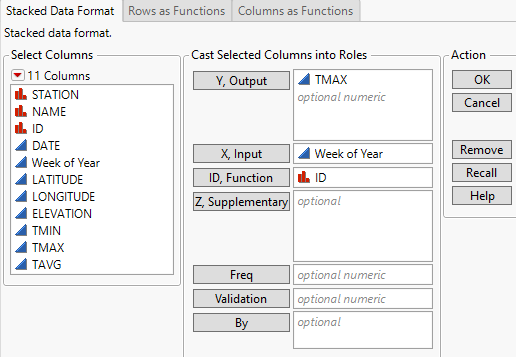 Launch the Functional Data Explorer Platform
Launch the Functional Data Explorer Platform
Launch the Functional Data Explorer platform by selecting Analyze > Specialized Modeling > Functional Data Explorer.
Figure 16.5 Functional Data Explorer Launch Window
For more information about the options in the Select Columns red triangle menu, see “Column Filter Menu” in Using JMP.
Select Data Format
The Functional Data Explorer launch window includes tabs for different types of data formats. Select the tab based on your data format.
Stacked Data Format
Select for data tables where each row corresponds to a single observation. There are separate columns for the output, input, and ID variables.
Note: The Stacked Data Format is the only data format that enables you to specify multiple functional processes. If you assign more than one column to Y, Output in the Stacked Data Format tab, each Y variable is analyzed separately. A Fit Group report contains the individual reports for the Y variables.
Rows as Functions
Select for data tables where each row corresponds to the full output function for one level of the ID variable. Each column corresponds to a level of the input variable.
Tip: If the columns contain the FDE X column property, the column property is used to specify the values of the input variable. If the columns do not contain the column property, the Rows as Functions data format uses the levels of the input variable specified in the column names. If the column names are too complicated, an error message is shown to indicate which columns were problematic and the values are specified as x = 1, 2, ..., n, where n is the number of observations in the function. For example, t20 2 and x30v20 are problematic column names.
Columns as Functions
Select for data tables where each column corresponds to the entire output function for one level of the ID variable. Each row corresponds to a level of the input variable.
Specify Column Roles
The launch window contains the following options for specifying the column roles.
Y, Output
Assigns the functional process, f(t). There must be at least two observed output values for each level of the ID variable.
Note: Functions with fewer than two observed output values are removed from the analysis.
X, Input
(Available only for the Stacked Data Format and Columns as Functions tabs.) Assigns the input variable t. If no variable is specified for X, Input, the row number is used. Using the row number assumes that the observations are equally spaced in the input domain.
ID, Function
(Available only for the Stacked Data Format and Rows as Functions tabs.) Assigns the ID variable to each function. For Stacked Data, if no ID variable is assigned all observations are assumed to come from one function.
Z, Supplementary
(Available only for the Stacked Data Format and Rows as Functions tabs.) Assigns one or more supplementary variables. Supplementary variables are not used in any of the calculations in the Functional Data Explorer platform and including them does not affect the results. Supplementary variables are variables that you might want to use in future analyses of the results from Functional Data Explorer. When you specify supplementary variables, they are included in a Supplementary column group in the tables that are created by the Save Data and Save Summaries options. These columns retain any column properties that were specified in the original data table. A Functional DOE Analysis option is also made available for the fitted models. See Functional DOE Analysis.
Freq
(Available only for the Stacked Data Format tab.) Assigns a column whose numeric values represent a frequency for each row in the analysis. The effect of a frequency column is to expand the data table, so that any row with integer frequency k is expanded to k identical rows.
Validation
Assigns an optional numeric column that defines the validation sets. This column should contain only two distinct values. The smaller value defines the training set and the larger value defines the validation set. If there are more than two values, the smallest value defines the training set and all other values define the validation set. The FDE platform uses the validation column to train and evaluate the model. For more information about validation, see “Validation in JMP Modeling”.
Note: The Validation option enables you to hold out complete functions, not a sample of observations from each function. Therefore, all observations that have the same ID value must be classified as either test or validation. You cannot have observations with the same ID value in both sets. For more information about this type of validation column, see “Grouped Validation Column”.
Caution: If you click the Validation button with no columns selected in the Select Columns list, and add a validation column to your data table, it will not be a grouped validation column. Instead, use the Make Validation Column Platform, see “Grouped Validation Column”.
By
Assigns a column that creates a report consisting of separate analyses for each level of the variable. If more than one By variable is assigned, a separate analysis is produced for each possible combination of the levels of the By variables.
